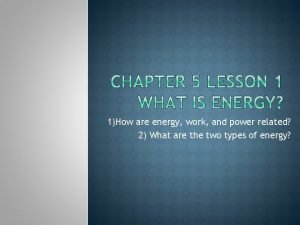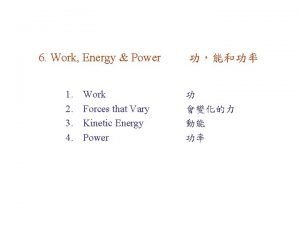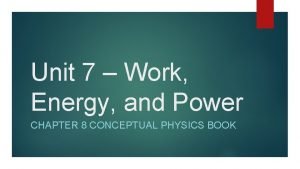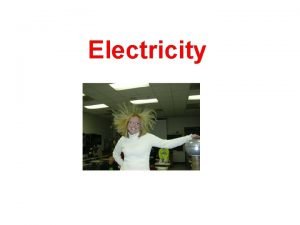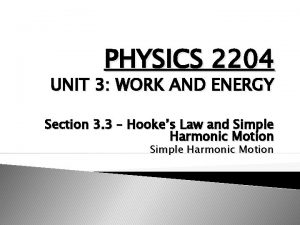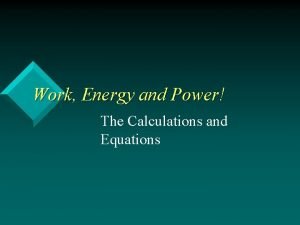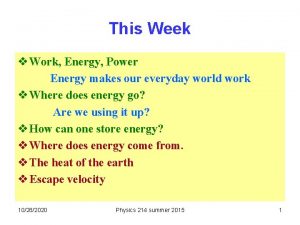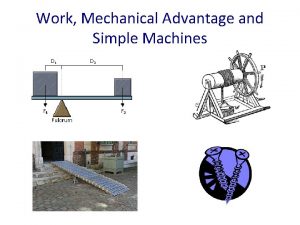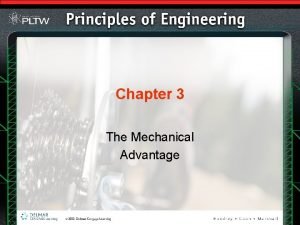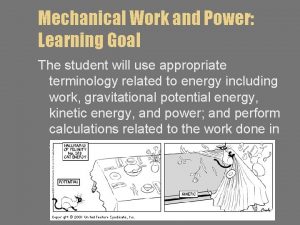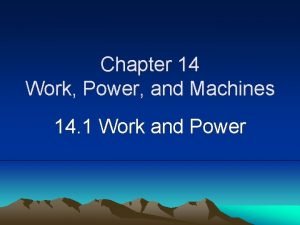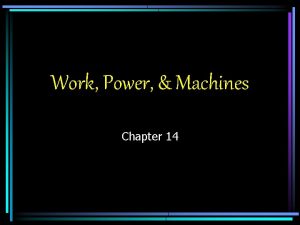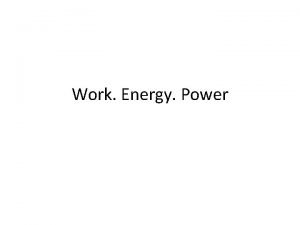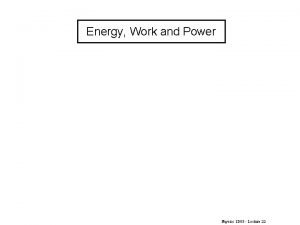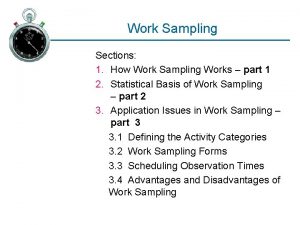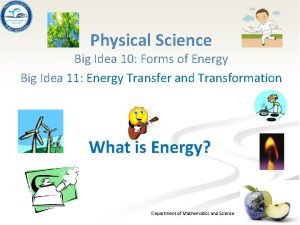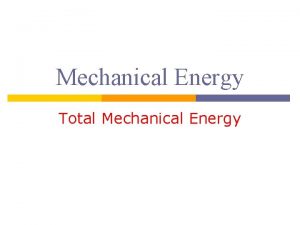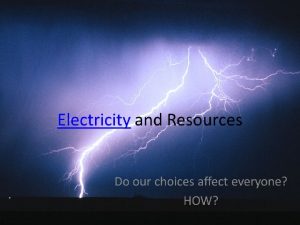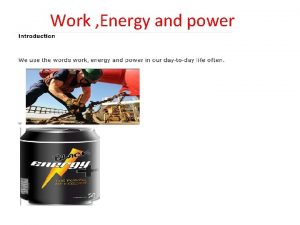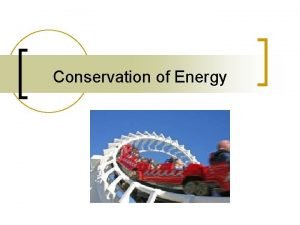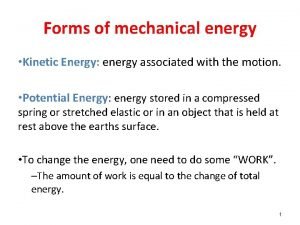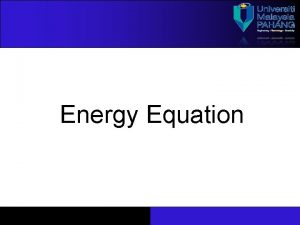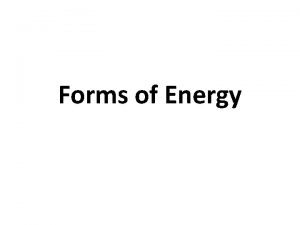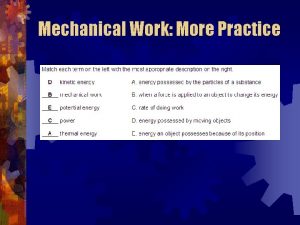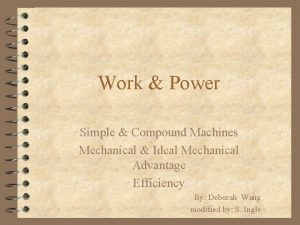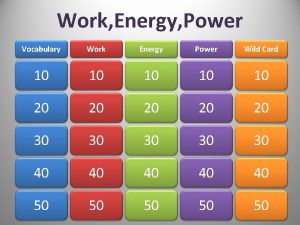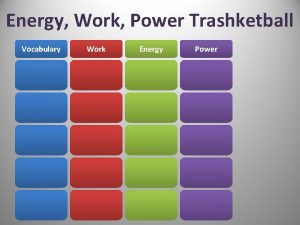Energy Work and Power Forms of energy Mechanical


























































- Slides: 58

Energy: Work and Power

Forms of energy Mechanical energy Radiant energy Energy comes in many forms. Nuclear energy Electrical energy Chemical energy Thermal energy Internal energy of gases

Mechanical energy Radiant energy Mechanical energy includes energy associated with motion and position. Nuclear energy Examples of mechanical energy include: Electrical energy • kinetic energy Chemical energy • gravitational potential energy • elastic potential energy Thermal energy Internal energy of gases

Radiant energy Mechanical energy Radiant energy includes all forms of electromagnetic radiation. Examples include: Nuclear energy • visible light Electrical energy • infrared radiation • ultraviolet light • microwaves • radio waves • x-rays Chemical energy Thermal energy Internal energy of gases

Nuclear energy Mechanical energy Radiant energy Nuclear energy comes from the forces that hold the atomic nucleus together. Nuclear energy Electrical energy Any change in an atom’s nucleus absorbs or releases nuclear energy. Chemical energy Nuclear energy is the energy source for the Sun and stars. Thermal energy Internal energy of gases

Electrical energy Mechanical energy Radiant energy Electrical energy is carried by electric currents. Electrical energy is clean, moves easily through wires, and is a key energy resource in human technology. Electrical energy must be derived from other forms of energy, such as nuclear or chemical energy. Nuclear energy Electrical energy Chemical energy Thermal energy Internal energy of gases

Chemical energy Mechanical energy Radiant energy Chemical energy is energy stored in the bonds between atoms. Nuclear energy When chemical bonds are changed through chemical reactions, chemical energy is released. Chemical energy is found in foods and fuels. Thermal energy Electrical energy Internal energy of gases

Thermal energy Mechanical energy Radiant energy Thermal energy is energy due to temperature. An object at a higher temperature has more thermal energy than if it was at a lower temperature. The thermal energy also depends on the mass and material of the object. Nuclear energy Electrical energy Chemical energy Thermal energy Internal energy of gases

Fluid pressure Mechanical energy Radiant energy Fluid pressure in gases and liquids creates a form of stored energy. The high-pressure air in a bicycle tire has more energy (per cubic centimeter) than the lowerpressure air outside. Nuclear energy Electrical energy Chemical energy Thermal energy Internal energy of gases

The meaning of energy Mechanical energy Radiant energy Nuclear energy Energy is the mediator of all physical changes, such as changes in speed, height, temperature, or chemical composition. Energy is measured in joules. Electrical energy Chemical energy Thermal energy Internal energy of gases

Energy of motion Kinetic energy is energy due to motion. It depends on the mass of an object, and its speed.

Energy of motion Kinetic energy is energy due to motion. A 1 liter water bottle (1 kg) moving at 1 m/s (2. 4 mph) has a kinetic energy of. . .

Energy of motion Kinetic energy is energy due to motion. A 1 liter water bottle (1 kg) moving at 1 m/s (2. 4 mph) has a kinetic energy of 0. 5 joules.

Engaging with the concepts What is the speed of a 2000 kg car that has a kinetic energy of 500, 000 joules?

Engaging with the concepts What is the speed of a 2000 kg car that has a kinetic energy of 500, 000 joules? 22. 36 m/s. Convert to miles per hour. One meter per second equals 2. 237 mph. Speed 500000 22. 36

Engaging with the concepts What is the speed of a 2000 kg car that has a kinetic energy of 500, 000 joules? 22. 36 m/s. Convert to miles per hour. One meter per second equals 2. 237 mph. Speed 500000 22. 36

Calculating kinetic energy The kinetic energy increases as the square of the speed.

Calculating kinetic energy The kinetic energy increases as the square of the speed. If the speed triples, how does the kinetic energy change?

Calculating kinetic energy The kinetic energy increases as the square of the speed. If the speed triples, how does the kinetic energy change? 32 = 9 The kinetic energy increases by a factor of 9.

Kinetic energy comes from work

Gravitational potential energy This heavy container has been raised up above ground level. Due to its height, it has stored energy —gravitational potential energy. Energy of Position. How do we know that the energy is there?

Gravitational potential energy This heavy container has been raised up above ground level. Due to its height, it has stored energy —gravitational potential energy. If the container is released, the stored energy turns into kinetic energy.

Gravitational potential energy If the mass of the container increases, its potential energy will also increase. If the height of the container increases, its potential energy will also increase.

Gravitational potential energy The gravitational potential energy of an object is. . .

Gravitational potential energy m m The gravitational potential energy of an object is the mass m in kilograms. . . x

Gravitational potential energy g g The gravitational potential energy of an object is the mass m in kilograms multiplied by the local acceleration due to gravity g (which is 9. 8 m/s 2 near Earth’s surface). . .

Gravitational potential energy h h The gravitational potential energy of an object is the mass m in kilograms multiplied by the local acceleration due to gravity g (which is 9. 8 m/s 2 near Earth’s surface), multiplied by the height h in meters.

Gravitational potential energy How can you give an object gravitational potential energy?

Gravitational potential energy How can you give an object gravitational potential energy? Gravitational potential energy comes from work done against gravity. . .

Gravitational potential energy How can you give an object gravitational potential energy? Gravitational potential energy comes from work done against gravity. . . … such as the work you do when you lift this bottle of water.

Gravitational potential energy Where does the formula for gravitational potential energy come from? Ep = mgh

Gravitational potential energy Where does the formula for gravitational potential energy come from? Ep = mgh The gravitational potential energy stored in an object equals the work done to lift it.

Deriving the formula Work is force times distance. W = Fd

Deriving the formula Work is force times distance. W = Fd F = mg To lift an object, you must exert an upward force equal to the object’s weight.

Deriving the formula Work is force times distance. W = Fd F = mg d=h The distance you lift it is the height h.

Deriving the formula Work is force times distance. W = Fd = mgh = Ep F = mg force = weight d=h distance = height

Athletics and energy How much energy does it take to raise a 70 kg (154 lb) person one meter off the ground?

Athletics and energy How much energy does it take to raise a 70 kg (154 lb) person one meter off the ground? This is a good reference point. It takes 500 to 1, 000 joules for a very athletic jump.

Does the path matter? A set of identical twins wants to get to the top of a mountain. • One twin hikes up a winding trail. • The second twin takes the secret elevator straight to the top. Which twin has the greatest potential energy at the top?

Path independence The twins have the SAME potential energy at the top. It doesn’t matter HOW they gained height. Changes in potential energy are independent of the path taken.

Brainstorm A 1200 kg sports car accelerates from 0 to 60 mph (27 m/s) in 5. 0 seconds. An typical car of equal mass takes 8. 0 seconds to do the same thing. So what’s the difference?

Power The difference is power. Both cars convert the chemical energy of their gasoline into the same amount of kinetic energy. . . but the sports car converts energy at a faster rate. It converts more energy every second. The sports car has greater power.

Power Any event in which energy is transformed involves power. Power is typically measured in watts.

An elephant versus an ant An elephant lifts a 300 kg log to a height of 3. 0 meters in a time of four seconds. An ant can lift several times its own body weight in a time of two seconds. Which one is more powerful?

An elephant versus an ant The elephant is more powerful, of course! The elephant transforms more chemical energy (from her cells) into gravitational potential energy each second.

Power is a rate Power is the rate at which work is done. Lifting a ball quickly requires more power than lifting it slowly. Power = Work time

Test your knowledge Nala does twice as much work as Mateo in the same amount of time. How much power does she have, compared to Mateo?

Test your knowledge Nala does twice as much work as Mateo in the same amount of time. How much power does she have, compared to Mateo? Twice as much power. Alonzo and Irina do the same amount of work, but Irina takes twice as long. How much power does Alonzo have, compared to Irina?

Test your knowledge Nala does twice as much work as Mateo in the same amount of time. How much power does she have, compared to Mateo? Twice as much power. Alonzo and Irina do the same amount of work, but Irina takes twice as long. How much power does Alonzo have, compared to Irina? Twice as much power.

Calculating power An elephant lifts a 300 kg log to a height of 3. 0 meters in a time of 4. 0 seconds. How much power is required? What is the first step?

Calculating power An elephant lifts a 300 kg log to a height of 3. 0 meters in a time of 4. 0 seconds. How much power is required? First, find the energy transformed. The elephant converts energy from her cells into the potential energy of the log.

Calculating power An elephant lifts a 300 kg log to a height of 3. 0 meters in a time of 4. 0 seconds. How much power is required? First, find the energy transformed. The elephant converts energy from her cells into the potential energy of the log. Then calculate the power:

Calculating power An elephant lifts a 300 kg log to a height of 3. 0 meters in a time of 4. 0 seconds. How much power is required? First, find the energy transformed. The elephant converts energy from her cells into the potential energy of the log. Then calculate the power:

Units for power The average power of a sports car is 84, 100 watts. This is such a large number. How else can it be expressed? There are two other ways: 1) Convert it to kilowatts: 2) What other unit often used for the power of a car?

Units for power What other unit often used for the power of a car? The horsepower! One horsepower equals 746 watts. For the sports car: This is the average power output for the entire event. The power needed at each instant keeps increasing as the velocity increases.

Energy The energy transformed in an event can be computed if the power is known. Start with the power equation. Multiply both sides by Δt. Cancel the Δt’s on the right side and swap the sides.

Calculating energy A toaster oven operating at 800 watts takes one and a half minutes to toast a bagel. How much energy is this?

Calculating energy A toaster oven operating at 800 watts takes one and a half minutes to toast a bagel. How much energy is this?
 Section 4 review physical science
Section 4 review physical science Define kinetic energy in physics
Define kinetic energy in physics Draw the power triangle
Draw the power triangle Work, power and energy activities
Work, power and energy activities Definition of work done
Definition of work done How are energy work and power related
How are energy work and power related Work power energy and machines
Work power energy and machines Definition of work power and energy
Definition of work power and energy Work power and energy
Work power and energy Unit 7 work energy and power answers
Unit 7 work energy and power answers Eroei
Eroei Work energy theorem
Work energy theorem W=fd
W=fd How to convert mechanical energy to electrical energy
How to convert mechanical energy to electrical energy What is an example of mechanical energy
What is an example of mechanical energy Electrical energy to mechanical energy
Electrical energy to mechanical energy Actual mechanical advantage vs ideal mechanical advantage
Actual mechanical advantage vs ideal mechanical advantage Was not short form
Was not short form Weak and strong forms
Weak and strong forms 0kei0
0kei0 Unit of resistivity
Unit of resistivity Physics 2204 unit 3: work, power, energy
Physics 2204 unit 3: work, power, energy Work energy power equations
Work energy power equations F= ma units
F= ma units Section 2 describing energy
Section 2 describing energy Why are related forms more agreeable than unrelated forms
Why are related forms more agreeable than unrelated forms Why are related forms more agreeable than unrelated forms
Why are related forms more agreeable than unrelated forms Why are related forms more agreeable than unrelated forms?
Why are related forms more agreeable than unrelated forms? Mechanical machine
Mechanical machine Section 1 work and machines answer key
Section 1 work and machines answer key How does mechanical advantage work
How does mechanical advantage work How does mechanical advantage work
How does mechanical advantage work Ideal mechanical advantage definition
Ideal mechanical advantage definition Mechanical work definition
Mechanical work definition Energy energy transfer and general energy analysis
Energy energy transfer and general energy analysis Energy energy transfer and general energy analysis
Energy energy transfer and general energy analysis Solar power satellites and microwave power transmission
Solar power satellites and microwave power transmission Actual power and potential power
Actual power and potential power The dispersive power of a grating is defined as the
The dispersive power of a grating is defined as the Work power and efficiency
Work power and efficiency Define work and power
Define work and power Unit 14 lesson 1 drivers ed
Unit 14 lesson 1 drivers ed An airplane passenger carries a 215 n suitcase
An airplane passenger carries a 215 n suitcase How to calculate work and power
How to calculate work and power Chapter 14 work power and machines
Chapter 14 work power and machines Chapter 14 section 1 work and power
Chapter 14 section 1 work and power Chapter 14 work power and machines
Chapter 14 work power and machines Chapter 8 work and power answers
Chapter 8 work and power answers Hans full is pulling on a rope to drag
Hans full is pulling on a rope to drag Work and power definition
Work and power definition Work versus energy
Work versus energy Kids and the power of work
Kids and the power of work Kapow kids
Kapow kids Power physics
Power physics A crate of bananas weighing 3000 n
A crate of bananas weighing 3000 n Rpd work authorization
Rpd work authorization Work sampling forms
Work sampling forms What are 6 forms of energy
What are 6 forms of energy Energy in science
Energy in science





